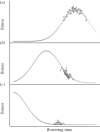Phenotypic plasticity and adaptive evolution contribute to advancing flowering phenology in response to climate change
- PMID: 22787021
- PMCID: PMC3415914
- DOI: 10.1098/rspb.2012.1051
Phenotypic plasticity and adaptive evolution contribute to advancing flowering phenology in response to climate change
Abstract
Anthropogenic climate change has already altered the timing of major life-history transitions, such as the initiation of reproduction. Both phenotypic plasticity and adaptive evolution can underlie rapid phenological shifts in response to climate change, but their relative contributions are poorly understood. Here, we combine a continuous 38 year field survey with quantitative genetic field experiments to assess adaptation in the context of climate change. We focused on Boechera stricta (Brassicaeae), a mustard native to the US Rocky Mountains. Flowering phenology advanced significantly from 1973 to 2011, and was strongly associated with warmer temperatures and earlier snowmelt dates. Strong directional selection favoured earlier flowering in contemporary environments (2010-2011). Climate change could drive this directional selection, and promote even earlier flowering as temperatures continue to increase. Our quantitative genetic analyses predict a response to selection of 0.2 to 0.5 days acceleration in flowering per generation, which could account for more than 20 per cent of the phenological change observed in the long-term dataset. However, the strength of directional selection and the predicted evolutionary response are likely much greater now than even 30 years ago because of rapidly changing climatic conditions. We predict that adaptation will likely be necessary for long-term in situ persistence in the context of climate change.
Figures




References
-
- Inouye D. W. 2008. Effects of climate change on phenology, frost damage, and floral abundance of montane wildflowers. Ecology 89, 353–36210.1890/06-2128.1 (doi:10.1890/06-2128.1) - DOI - DOI - PubMed
-
- Thomson J. D. 2010. Flowering phenology, fruiting success, and progressive deterioration of pollination in an early-flowering geophyte. Phil. Trans. R. Soc. B 365, 3187–319910.1098/rstb.2010.0115 (doi:10.1098/rstb.2010.0115) - DOI - DOI - PMC - PubMed
-
- Pilson D. 2000. Herbivory and natural selection on flowering phenology in wild sunflower, Helianthus annuus. Oecologia 122, 72–8210.1007/PL00008838 (doi:10.1007/PL00008838) - DOI - DOI - PubMed
-
- Anderson J. T., Lee C. R., Mitchell-Olds T. 2011. Life-history QTLs and natural selection on flowering time in Boechera stricta, a perennial relative of Arabidopsis. Evolution 65, 771–78710.1111/j.1558-5646.2010.01175.x (doi:10.1111/j.1558-5646.2010.01175.x) - DOI - DOI - PMC - PubMed
-
- Mitchell-Olds T. 1996. Genetic constraints on life-history evolution: quantitative-trait loci influencing growth and flowering in Arabidopsis thaliana. Evolution 50, 140–14510.2307/2410788 (doi:10.2307/2410788) - DOI - DOI - PubMed
Publication types
MeSH terms
Grants and funding
LinkOut - more resources
Full Text Sources
Other Literature Sources
